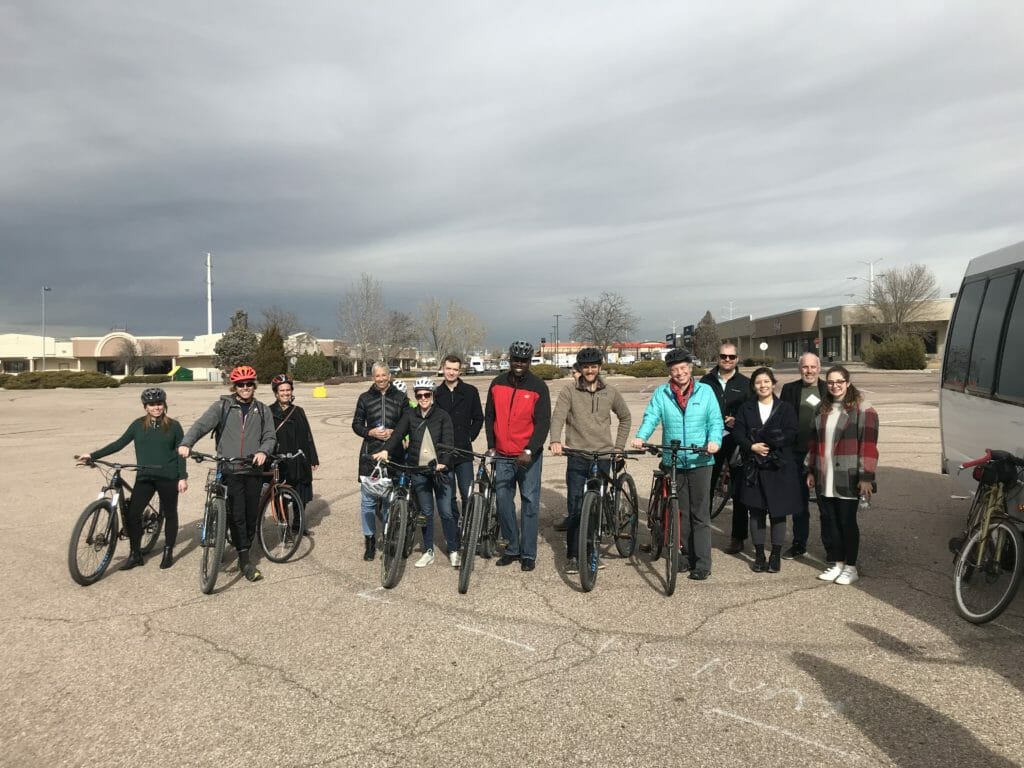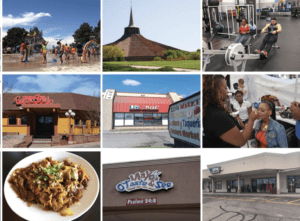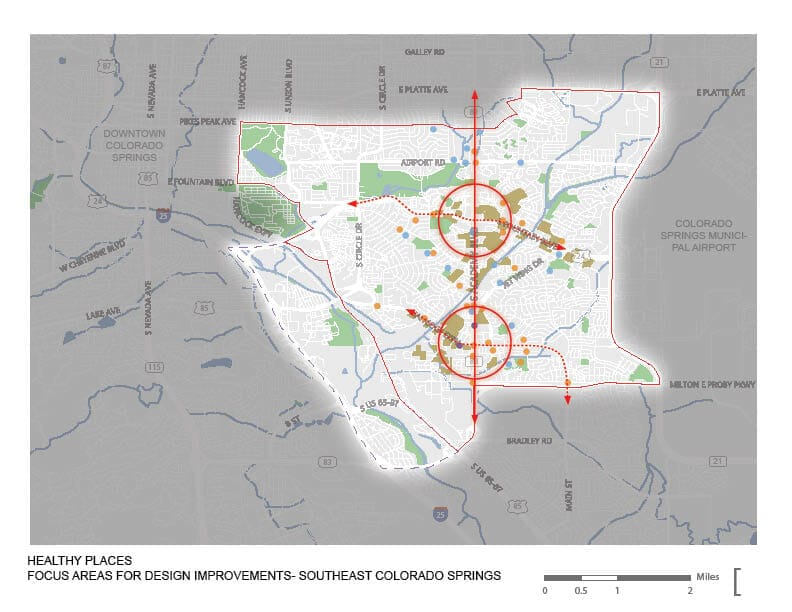Top Story
Date: January 7 – 12, 2018
Location: Colorado Springs, CO
Sponsor: Colorado Health Foundation, El Paso County Public Health
Subject Area: Building Healthy Places
Panel Chair: Andrew Irvine, Stantect, Denver, Colorado
Background and Panel Assignment
After years of disinvestment and underrepresentation, the Southeast Colorado Springs community is advocating for the resources to transform itself into a thriving, healthy, and safe place to live. Southeast Colorado Springs is a family-focused, 12 X 12 square miles community that is home to 16% of Colorado Spring’s population. Throughout some of the city, there is a negative perception of Southeast, as narratives of crime and poverty have become synonymous with the community. However, the residents want a new story to be told – one that highlights the successes of the people living and working in Southeast. The neighborhood is home to diverse cultures, incomes, religious affiliations, and perspectives, lending itself to become an area of the city known for its great food, fun music, and interesting cultural events. Despite the many economic disadvantages that exist in the Southeast, the community takes pride in its resiliency and ability to overcome difficult situations.
The Panel was tasked to come up with a set of strategic recommendations that address community needs and provide a road map for how to turn the panel’s recommendations and previous plans into actionable next steps. The ULI Advisory Services Panel was asked to examine the following:
- Make the case for investment, both public and private, for projects that increase community connections (physical, social, economic) and are also market sensitive. Provide financing and organization strategies for these projects.
- Apply the principles of building healthy places and experiential solutions to identify and prioritize projects that are both responsive to community needs and in alignment with the strategic direction of the City and region.
- Recommend realistic and resident-driven strategies to activate vacant spaces (buildings, parking lots, land) and underutilized public places that encourage community development.
- Prioritize ideas from existing plans and seek opportunities to implement those that have the potential to impact both community and economic health in the area – i.e., Economic Opportunity Zone incentives, community hub, street design.
This panel is part of the Colorado Health Foundation’s (CHF) Healthy Places Program, which supports community efforts to increase opportunities for safe physical activity. Through a community-led approach, Healthy Places supports communities to both improve upon their current assets and identify new possibilities to increase activity through physical improvements. Following a RFP for participation, CHF selected four communities from across that state that demonstrated both a need and desire for the program and an ability to implement the recommendations. Southeast Colorado Springs is the first of ULI’s advisory services panels for this round of the program, and will be followed up by panels in Commerce City, the City of Greeley, and the Montbello neighborhood in Denver.

Summary of Recommendations
Following a week of briefings, review of past plans and studies, study tours, and community interviews, the panel developed a number of strategic recommendations for Southeast Colorado Springs. The panel identified a myriad of small to large scale recommendations, and has organized them into five categories: Connect It, Getting Together, Organizing and Communicating, Health Access, and Making It Happen. Recommendations to begin working on immediately are summarized below:
Connect It:
- Safe Crossings: build upon and improve existing infrastructure to make sidewalks ADA compliant to help residents access their community. The panel also observed first hand an immediate need for more and better connected sidewalks, as the panel saw residents walking on busy roads next to cars without any type of safety barrier.
- Link to greater Colorado Springs: many residents of Southeast noted that they felt separated from and uncomfortable in other parts of Colorado Springs. One interviewee noted that it can take up to two hours on public transportation to get downtown. Increasing access to other parts of Colorado Springs is imperative to making the city whole.
- Links to Nature: the panel heard many people say that the best part of living in Colorado Springs is access to nature; however, Southeast is lacking the same connections to it as the rest of the City. Creating better access to the natural resource of the great outdoors will support better physical and mental health for Southeast residents.
- Maintain it: efforts have been started to promote connectivity within Southeast, these resources need continuous maintenance to reach their full potential.
Getting Together:
- Community Gathering Space: there is a great need and desire from Southeast residents to have a place to come together and celebrate. A gathering space or hub should be created that can accommodate a variety of community gathering events as well as everyday activities. Input from the community on the design and function of this space should be central to its creation.
- Temporary activation of vacant spaces: the panel believes that the vacant spaces in the Southeast can be used as opportunities for creative spatial solutions for other community issues. For example, painting an unused parking lot to become a pop up park or putting a seasonal farmers’ market inside a vacant building are examples of temporary solutions that can activate vacant spaces.
Organizing and Communicating:
- Community Advocacy: from the RISE Coalition, SWEAT Gym, to Just Breath, the Panel saw leadership growing from many different parts of the community. These efforts need to be given the resources to better collaborate and communicate.
- Community Communication: there is so much going on within the Southeast that it is easy for existing resources to get lost. A community calendar should be developed to highlight the existing events and resources.
- Community Branding: there is a discrepancy in Colorado Springs between the outside perception of the Southeast and the realities within the neighborhood. A community-led branding effort needs to be started from within to change this narrative. Storytelling is a wonderful way to create connections, re-affirm values, and restore hope.
Health Access:
- Health Taskforce and Needs Assessment: an area specific assessment of healthcare needs should be undergone to better understand what Southeast residents need. This should lead to the development of priority areas for investment.
- Community Gardens: creating community gardens both encourages healthy eating and teaches life skills. The panel heard that a few are already in the works at Solid Rock Christian Center, by the Colorado Springs Food Rescue, and at the Deerfield Community Center.
- Transit Connections: the panel heard from many residents that current public transportation in Southeast does not work for their lives. The panel suggests that a transit center be built, bus stops become sheltered, all buses be ADA compliable, and creative solutions to the “first and last mile” issue be taken under consideration.
- Mobile Clinics: for residents unable to access the social services scattered throughout Southeast, the panel suggests that a mobile clinic be created. This clinic could have resources such as healthy groceries, online banking, basic preventative care, and other needs as identified by the community it serves.
- Incorporating Principals of Building Healthy Places: for long-term success in creating a thriving community, ULI’s Ten Principles for Building Healthy Places should be incorporated into all future development plans.
Making it Happen:
- Reinforce Codes Enforcement: existing resources such as naturally occurring affordable housing need to be preserved, but also brought up to safe and healthy standards with the enforcement of city codes and regulations.
- Community Development Corporation: an entity needs to be put in charge of helping finance projects, move them along, and make sure that efforts are working in conjunction with each other.
- Redevelopment Incentives and Financing Mechanisms: should be identified and implemented for the projects listed above.

